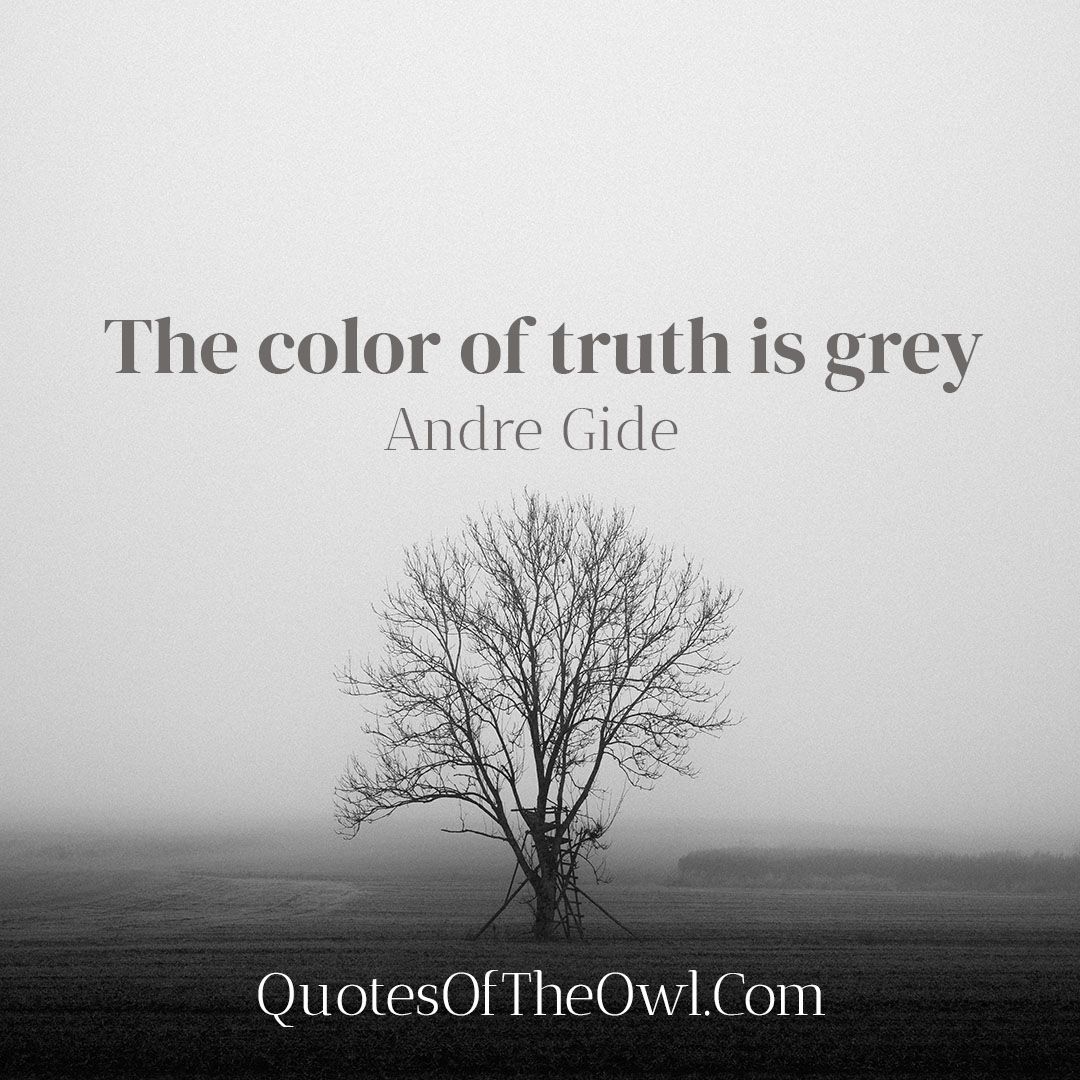The Color of Truth Is Grey – Andre Gide’s Quote Meaning
In the realm of truth, where do we find certainty and clarity? French author Andre Gide once stated, “The color of truth is grey.” This thought-provoking quote challenges our traditional notions of absolute truth, urging us to explore the nuances and complexities that lie within the grey areas. In this article, we will delve into the meaning behind Andre Gide’s quote and examine the implications it holds for our understanding of truth.
The Quote and Its Context
“The color of truth is grey” is a concise yet profound statement by Andre Gide. While the quote is often attributed to Gide, its precise origin within his works is a subject of debate. Regardless of its exact source, the quote encapsulates a crucial aspect of Gide’s philosophy, emphasizing the elusive nature of truth.
Exploring the Meaning
At first glance, Gide’s quote suggests that truth is not confined to black-and-white absolutes. Instead, it implies that truth resides in the vast spectrum of grey, where multiple perspectives and interpretations coexist. Gide challenges us to question our inclination towards binary thinking and embrace the uncertainties and complexities inherent in truth.
Embracing the Grey Areas
In a world that often seeks definitive answers, Gide’s quote encourages us to embrace the grey areas. It reminds us that truth can be multifaceted, shaped by diverse experiences and viewpoints. By acknowledging and exploring the grey, we gain a deeper understanding of the intricacies of truth.
The Nature of Truth
Gide’s quote prompts us to consider the nature of truth itself. Is truth an objective reality that exists independently, or is it a subjective construct influenced by our perceptions? The grey areas symbolize the inherent subjectivity of truth, reminding us that our understanding is often colored by our individual biases, emotions, and experiences.
Grey as a Symbol
Grey serves as a powerful symbol in Gide’s quote. It represents the ambiguity and complexity that exist within truth. Unlike black and white, grey encompasses a multitude of shades, suggesting the existence of various truths and interpretations. It calls for open-mindedness and an acknowledgment of diverse perspectives.
The Complexity of Truth
Gide’s quote highlights the intricate nature of truth. It suggests that truth is not a singular entity but a web of interconnected ideas and perspectives. The grey areas embody this complexity, urging us to dig deeper, question assumptions, and engage in critical thinking to unravel the layers of truth.
Truth and Subjectivity
Subjectivity plays a crucial role in the understanding of truth. Gide’s quote reminds us that truth is not solely based on objective facts but also on individual experiences and interpretations. Each person’s perception of truth may vary, influenced by their unique backgrounds, beliefs, and values. The grey areas symbolize this subjectivity, emphasizing the need to respect diverse viewpoints and engage in meaningful dialogue to arrive at a more comprehensive understanding of truth.
Cultural Perspectives on Truth
Cultures around the world have different conceptions of truth. Gide’s quote invites us to explore how cultural perspectives shape our understanding of truth. In some cultures, truth may be seen as absolute and unwavering, while in others, it may be seen as fluid and contextual. By acknowledging and appreciating these cultural variations, we broaden our perspective and develop a more inclusive approach to truth.
The Importance of Perspective
Perspective is a powerful lens through which we perceive and interpret the world. Gide’s quote reminds us that truth is deeply intertwined with perspective. Different viewpoints can shed light on various aspects of a situation, enriching our understanding of the truth. By actively seeking out diverse perspectives, we can overcome our biases and limitations, ultimately arriving at a more holistic view of truth.
Accepting Uncertainty
Gide’s quote challenges our desire for certainty and encourages us to embrace the inherent uncertainty of truth. The grey areas represent the gaps in our knowledge and the limitations of our understanding. Instead of seeking absolute certainty, Gide suggests that we should acknowledge and explore these uncertainties, fostering an open-minded and intellectually humble approach to truth.
Truth in Art and Literature
Art and literature have long been regarded as avenues for exploring truth. Gide’s quote prompts us to consider how artists and writers navigate the grey areas of truth in their works. Through storytelling and creative expression, they delve into the complexities of human experiences, offering nuanced perspectives and inviting readers to contemplate different truths. Art and literature allow us to engage with the grey, provoking introspection and challenging our preconceived notions.
Examples of Grey Truth
To better understand Gide’s quote, let us consider some examples of grey truth. Historical events often present multiple narratives and interpretations, revealing the complex nature of truth. Scientific discoveries, too, can challenge our existing understanding, leading to paradigm shifts and the emergence of new truths. Personal relationships, with their intricate dynamics and emotions, can also embody shades of grey, highlighting the subjectivity and complexity of truth in human interactions.
Conclusion
In conclusion, Andre Gide’s quote, “The color of truth is grey,” compels us to question the conventional notion of truth as a dichotomy between black and white. It encourages us to explore the vast spectrum of grey, where multiple perspectives and interpretations coexist. By embracing the uncertainties, complexities, and subjectivity inherent in truth, we gain a more nuanced understanding of the world and foster empathy and open-mindedness. The journey toward truth is not about reaching a final destination but about continuously engaging with the grey areas, expanding our perspectives, and embracing the richness of diverse truths.
Discover the profound wisdom of Andre Gide through his timeless quotes

